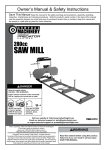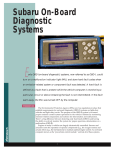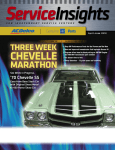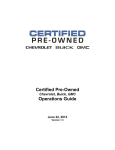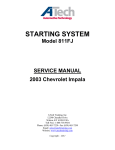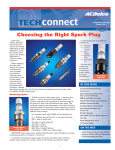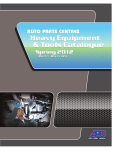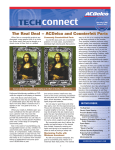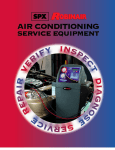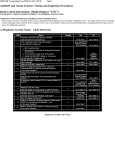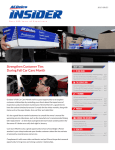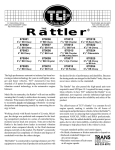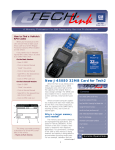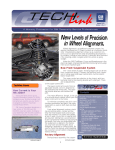Download Fuel Injector Cleaning
Transcript
October/November 2004 Volume 11, No.6 Fuel Injector Cleaning In time, fuel injector(s) may become restricted, due to buildup in the injector passages. Restrictions cause an injector to run lean. Driveability symptoms include difficult starts, rough operation and possible misfire. The MIL may illuminate. Injector cleaning has three phases: dealing with fretting corrosion, injector balance testing, and cleaning. Here are some of the reasons behind Typical Multec II Injector the procedures. ting is that it can cause symptoms that mimic a restricted injector. The worst case is a total loss of continuity in the connection that results in injector circuit fault or misfire codes being set. If the oxides create a high resistance circuit, insufficient current will be available to properly open the injector, resulting in unstable fuel delivery. Applying lubricant continued on page 3 IN THIS ISSUE Fretting Corrosion Fretting is a microscopic rubbing motion between the terminal pin on the injector and the terminal in the wiring harness, usually caused by injector vibration, engine vibration and electrical harness movement. It is invisible to the naked eye. Oxidized debris (corrosion), the result of fretting, can build up in the injector terminals, resulting in high resistance or loss of continuity. A fretted connection is unstable, and may vary between good, high resistance and open, depending on the amount of oxide build-up. The reason to be concerned about fret- conditions still exist for fretting to occur, it will eventually come back. To ensure that fretting is not an issue, apply dielectric grease to both cavities of each injector connector. This provides a lubricant for the terminals as well as an oxygen barrier to guard against oxide formation. The GM part number for dielectric grease in the U.S. is 12377900. In Canada, the GM part number is 10953529. To apply the lubricant, gather a small amount (about the size of a BB) on the end of your finger. Press it into the end of the disconnected female connector, making sure to cover both cavities. Reconnecting the harness connection onto the injector will wipe the lubricant onto the male terminal pins. Step 1. Stable connection Step 2. Progression of fretting corrosion Step 3. Formation of oxide layer Step 4. Unstable connection Disconnecting and reconnecting the injector connector will temporarily scrape the oxides off, creating a good connection. This explains why replacing a suspected faulty injector with a new injector appears to repair the condition. But, if the 1 Fuel Injector Cleaning . . . . . . . . . . . . . . . . . .1 Duramax 6600 Diesel Engine Seminar . . . .2 Top Tier Detergent Gasoline . . . . . . . . . . . .3 Making an Impact with Customers On Hold . . . . . . . . . . . . . . . . . . . . . . . . . . . .4 Get a Deal on a Dell . . . . . . . . . . . . . . . . . . .4 Buying a Business Grade Computer . . . . .4 The Mastertech CAN . . . . . . . . . . . . . . . . . .5 Iridium Spark Plug Questions . . . . . . . . . . .6 Sports Report . . . . . . . . . . . . . . . . . . . . . . . . .6 Tech Tips . . . . . . . . . . . . . . . . . . . . . . . . . . . . .7 Getting Ready for the Cold . . . . . . . . . . . . . .8 Ceramic Brake Pad Friction Material Data Online . . . . . . . . . . . . . . . . . . . . . . . .8 acdelcotechconnect.com New Duramax 6600 Diesel Engine Seminar Available A new ACDelco seminar on the Duramax 6600 diesel engine is now being conducted at Warehouse Distributors (WD). Duramax 6600 Diesel Engine (SS-FD-1.01) covers the unique features, such as the common rail fuel system, of the two Duramax 6.6-liter diesel engines, Regular Production Option (RPO) LB7 introduced in 2001 and RPO LLY introduced in 2004. The four-hour seminar has been designed for experienced diesel engine technicians. ACDelco TechConnect is published bi-monthly for retail technicians to provide timely service information, increase knowledge and improve the performance of the service center. Publisher & Editor: Greg Baker ACDelco E-mail / [email protected] RPO LB7 Engine Features The RPO LB7 Duramax 6600 diesel engine was produced between the 2001 and early part of 2004 model years. The LB7 diesel engine produces 300 horsepower at 3100 rpm and 520 lb.-ft. of torque at 1800 rpm and features a Robert Bosch direct injection fuel system that can produce fuel pressures up to a maximum of 23,000 psi. The first part of the seminar reviews the following major systems of the Duramax 6600 diesel engine, RPO LB7: • Mechanical • Lubrication • Cooling • Air induction and turbocharger • Glow plug • Crankcase ventilation • Fuel • Engine management Duramax features that are highlighted include the direct injection “common rail fuel system,” which provides an exact air/fuel ratio for every combustion stroke for maximum power, along with the efficiency of the four overhead valves per cylinder design and the fuel pulse shaping strategy. The common rail fuel system consists of a high pressure pump assembly, a fuel filter assembly, two common fuel rails (each rail supplies fuel to four injectors, hence the name common rail), a high pressure junction block (with a pressure limiting valve and a fuel pressure sensor) and a Fuel Injection Control Module (FICM). The common rail fuel system has several advantages over more traditional fuel systems, such as fuel injection pressure that is independent of engine speed and load as well as lower noise and less emissions due to pilot fuel injection pressure. Pilot injection uses a small amount of fuel that is injected at engine speeds below 2,500 rpm, followed immediately by normal injection. RPO LLY Engine Features The second part of the seminar covers the Duramax 6600 diesel engine, RPO LLY, which began production in January 2004. The LLY diesel engine produces more power than the RPO LB7 engine and is also used in medium-duty truck applications. It generates 310 horsepower at 3100 rpm and 590 lb.-ft. of torque at 1600 rpm. In addition to more power, this engine has a nearly 90% reduction in exhaust emissions for Hydrocarbons, Oxides of Nitrogen and particulates. The important changes made to the Duramax 6600 diesel engine, RPO LLY, that are covered in the seminar include: • Variable nozzle turbocharger • Digital Exhaust Gas Recirculation (EGR) • Fast heating glow plugs • Closed crankcase ventilating system • Revised fuel system Changes to the turbocharger, for example, contribute to the power gain of the LLY version of the Duramax 6600 diesel engine. An efficient turbocharger spins up fast to produce boost pressure early, but does not create excessive exhaust backpressure at the engine’s upper operating range. The variable nozzle turbocharger features a group of nine adjustable vanes in place of the wastegate used in the LB7 engine. The vanes are opened to minimize flow at the turbine and exhaust backpressure at low engine speeds. To increase turbine speed, the vanes are closed, increasing the velocity of the exhaust gases. The variable nozzle turbocharger allows for a quicker-acting turbocharger at low power levers while significantly reducing turbine-induced exhaust backpressure at high power and rpm levels. To learn more about the features of the Duramax 6600 diesel engine, contact your WD to find out when the Duramax 6600 Diesel Engine seminar will be held in your area. For a more in-depth study of the Duramax 6600 diesel engine, enroll in the two-day Duramax 6600 training course FCD-11. You can review the current ACDelco training schedule and enroll in courses online by clicking on the Training link at acdelcotechconnect.com. 2 Technical Editors: Mark Spencer E-mail / [email protected] Jim Horner E-mail / [email protected] Desktop Publishing: Greg Szpaichler, MediaWurks E-mail / [email protected] Write to: * ACDelco TechConnect P.O. Box 500 Troy, MI 48007-0500 : On the Web: acdelcotechconnect.com ACDelco service tips are intended for use by professional technicians, not a “do-it-yourselfer.” They are written to inform those technicians of conditions that may occur on some vehicles, or to provide information that could assist in the proper service of a vehicle. Properly trained technicians have the equipment, tools, safety instructions and know-how to do a job properly and safely. If a condition is described, it cannot be assumed that the information applies to all vehicles or that all vehicles will have that condition. All materials and programs described in this magazine are subject to change. Submission of materials implies the right to edit and publish. Inclusion in the publication is not necessarily an endorsement of the individual or the company. TechConnect is published for ACDelco by Sandy Corporation, Troy, MI. ©2004 ACDelco. All rights reserved. Fuel Injector Cleaning — from page 1 Properly applied lubricant Injector Balance Testing An important reason for balance testing is that it quickly and graphically indicates the flow of each injector, and permits comparing the performance of each injector with the others. The balance test determines the condition of the injectors on the vehicle by comparing injector pressure drops. An initial fuel system pressure is achieved for each injector. Each injector is individually pulsed with the same number of pulses for the same time duration. By using two constants (starting fuel system pressure and pulse width/duration), the differences in injector can be compared based on the fuel pressure dropped by each injector as it is pulsed. The balance test procedure calls for attaching a pressure gauge to the fuel rail. The gauge must be in good operating condition and capable of reading in kilopascals (kPa). The reason for reading kPa instead of psi is that kPa is a much smaller measuring increment, which permits a much more precise measurement. It takes a difference of only 20 kPa between injectors to cause a misfire. 20 kPa is equivalent to 3 psi. Most psi gauges do not have enough resolution to accurately represent such small changes. To perform the test, connect the pressure gauge to the fuel rail pressure connection. Purge air from the gauge by opening the valve on the side of the gauge and cycling the fuel pump (this can be accomplished by turning the ignition switch on, then off for 30 seconds, then back on). Fuel system pressure must be at the desired specification in the service manual. Fuel pressure must not leak down at a rate of more than 5 kPa in 30 seconds. If a concern exists, follow diagnostics in the service manual. Next, connect the scan tool and select Injector Balance Test. Select injector 1. The fuel system will prime. Record the Initial Pressure reading immediately after the fuel pump shuts off. It is normal for the fuel system pressure to rise due to warm fuels vaporizing. Pulse the first injector and record the Pressure After Pulse reading immediately after the injector stops pulsing. Select and test each remaining injector, recording both the Initial Pressure and Pressure After Pulse readings. Once the testing is completed, subtract the Pressure After Pulse reading from the Initial Pressure reading for each cylinder to determine the pressure drop. After determining the amount of pressure drop for each injector, compare the results. If the difference between the highest (richest) and lowest (leanest) injector is less than 20 kPa, the injectors are all flowing within an acceptable range. If the difference is 20 kPa or more, proceed with cleaning. An injector that is considerably richer than the rest must be replaced. An injector that is leaner than the rest may be restricted, and may benefit from cleaning. Research indicates that an injector running lean could lead to a driveability condition. Injector Cleaning GM Top-Engine Cleaner is an effective cleaner that won’t cause damage to plastic or metal components in the fuel injection system when used as instructed. The GM part number for GM Top Engine Cleaner in the U.S. is 12346535. It’s packaged in pre-measured 0.812 oz. (24 ml) bottles. In Canada, the part number is 992872 and it’s packaged in a15 oz. (443.6 ml) bottle. Typically, the injector cleaning process is run twice to ensure thorough cleaning of the injectors. For each batch of cleaning agent, add two 24 ml bottles (US) or measure 1.6 oz. (48 ml) (Canada) into the J-35800 injector cleaning tool and top off with unleaded gasoline. This will result in a 10% mixture. Research shows that concentrations greater than 10% do not improve effectiveness. J-35800 Fuel Injector Cleaner Follow the tool instructions when hooking up the injector cleaner equipment. It’s important to use the appropriate special tools to block the fuel feed and return lines. The reason is to isolate the cleaning agent to the fuel rail only, and to prevent getting it into the fuel tank, which could damage the fuel pump check ball. For more information about how to test and clean Multec II injectors, refer to GM bulletin 03-06-04-030A. To learn more about fuel systems, check out ACDelco training course FC-2.02, Electronic Fuel Systems. New Top Tier Detergent Gasoline Top Tier Detergent Gasoline, a new class of unleaded gasoline with enhanced detergency that minimizes deposits on fuel injectors, intake valves, and combustion chambers, will be appearing at retail stations of some fuel marketers. This gasoline meets new, voluntary deposit control standards developed by BMW, General Motors, Honda and Toyota. The U.S. EPA requires all gasoline sold in the U.S. to contain a detergent additive. However, the requirement is minimal and in many cases is not sufficient to keep engines clean. A higher level of detergent is needed than what is required by the EPA. Top Tier Detergent Gasoline exceeds the detergent requirements imposed by the EPA. The four corporations recognized the benefits to both the vehicle and the consumer. Also, joining together emphasized that low detergency is an issue of concern to several automotive companies. All vehicles will benefit from using Top Tier Detergent Gasoline, which will help keep engines cleaner than gasoline containing the lowest additive concen- 3 tration set by the EPA. Clean engines help provide optimal fuel economy and performance, and reduced emissions. Those vehicles that have experienced deposit- related problems would especially benefit from use of Top Tier Detergent Gasoline. The Top Tier program, begun on May 3, 2004, is a voluntary program initiated by the four automotive companies. Some fuel marketers have already joined, although not all fuel marketers will offer Top Tier Detergent Gasoline. Once fuel marketers make public announcements, a list of all fuel marketers meeting Top Tier standards will be made available. Here’s a list of gasoline brands that currently meet Top Tier standards. • Chevron – Chevron has markets in 29 states in the West, Southwest and South. • QuikTrip – QuikTrip (not to be confused with Kwik Trip) operates convenience stores and travel centers in nine states in the South and Midwest. Make an Impact with Customers On Hold Get a Deal on a Dell The phone rings in your service center. What are the odds that you’ll have to place the customer calling in on hold? According to AT&T, seven out of 10 business calls are placed on hold. But if you place the customer on hold, how can you sell yourself to those on the other end of the phone line in order to avoid a hang up? After all, studies show that almost 60% of callers will hang up after being placed on hold. It’s important that you take care of the customers you’re working with in your service center. However, that doesn’t mean you can’t get your message across quickly and professionally to potential customers who are on hold. ACDelco has teamed up with American Impact Media Corp. to offer Total Service Support (TSS) participants on-hold messages that help sell your business while customers wait on hold. An on-hold message is an audio recording that mixes licensed music with professionally recorded messages that play continuously while your callers are on hold. Having a message on-hold system reduces call abandonment by almost 90% and increases customers’ hold time by over 500%. There are many benefits with on hold messages: • Tell your customers you care about them and appreciate their business. • Promote the goods and services your service center has to offer. • Introduce new products while promoting a professional image. • Discourage hang ups when callers are put on hold. • When customers are put on hold, make the wait worthwhile. The customized on-hold messages are produced by American Impact, which provides telecommunications and advertising services to businesses worldwide. They offer custom copywriting of multiple messages, so each onhold message is tailored for your business. Messages may provide important information about your service, such as your location or years in business. You may also want to promote the variety of services you offer or advertise specific products. Each message will be produced with American Impact’s state-ofthe-art digital message equipment, using professional voice talent and their extensive library of background music. Several examples of on-hold messages are available on American Impact’s web site. For more information about how to develop and enhance the image of your service center with on-hold messaging, visit www.americanimpact.com or call Fred Spieler at American Impact at 1-800-664-6534. By participating in the ACDelco Total Service Support (TSS) program, independent service centers realize a number of benefits that grow their business and help it succeed. But being a TSS service center also has many benefits for the service center’s employees. One of those benefits is a discount on Dell computer equipment. TSS service center employees are eligible to buy Dell personal computer equipment through Dell’s Employee Purchase Program. The Dell systems available for purchase are not intended for use with WISE. Through the program, you’ll receive: • 5-10% off Dell’s list prices on Dimension desktop PCs and Inspiron notebook computers as well as electronics and accessories, printers, digital cameras and more. (The discount is 5% on computer systems with a 1-2 year warranty and 10% on computer systems with a 3-4 year warranty.) Plus, special employee discounts listed on the employee purchase program web site may be applicable. • Access to the 24/7 Dell Technical Service & Support Line for the life of your computer. • Available Dell purchase plans through Dell Financial Services for qualified buyers. For additional information or to order online from Dell’s Employee Purchase Program web site, visit www.dell.com/eppbuy. The TSS participant I.D. is GS142116812. If you would like assistance in configuring or ordering a Dell computer system, call a Dell representative at 1-800-695-8133. Buying a Business Grade Computer Having the correct PC has become as important to the service center’s efficiency and productivity as having the right tools in the toolbox. When upgrading and adding computer equipment to your service center, business grade or commercial PCs are recommended. Unlike a consumer grade PC, a business grade PC is specifically configured for use in a business network environment. PCs in this class have components designed and supported for use in a network environment. Additionally, they have greater life cycle stability due to designed-in serviceability. Characteristics of Business Grade PCs • Extended product availability cycles • Built using same components for generally three to six months • Ease of serviceability of internal components • Preloaded with business software • Network manageability, utilizing industry standards to manage setup and maintenance Characteristics of Consumer Grade PCs • Designed with multi-media hardware features used for gaming, video and music • Preloaded with multi-media software designed for entertainment 4 • Not assembled with same internal components through product build lifecycle • Designed for home networking configurations • Preloaded with Internet-ready configurations designed for the home user For TSS service centers that utilize ACDelco’s WISE System, there are specific computer hardware requirements, which are needed in order to fully take advantage of all of the features of the system. Because of continuous advancements in personal computer hardware as well as enhancements to the WISE System, please contact your Regional eBusiness Coordinator to discuss your computer needs. The Mastertech CAN A decade has now passed since the first OBDII compliant vehicles rolled off the assembly line. When looking back at that period of automotive history and reflecting on what impact the changes in technology had in the repair process, a few things come to mind immediately. First, service centers had to either upgrade their scan tools or replace them to communicate with the four new EPA-legislated OBD protocols. Second, additional training was required to learn not only how the systems worked, but how they were diagnosed and repaired when they rolled into the shop. Third, OBDII, overall, was very good for the repair industry. It provided better diagnostic information on more vehicles than ever before, and the do-it-yourself crowd has diminished, creating a larger customer base for professional service centers. Controller Area Network What now? The EPA has added a new OBDII protocol to the lineup that started in model year 2003 called CAN, or Controller Area Network. Developed originally by the Robert Bosch Corporation in the mid-1980s for Mercedes-Benz, it is now mandated to be on all vehicles by model year 2008, with a gradual phase-in already in progress. The speed of CAN enables sharing of real-time data. Vehicle systems with these requirements are primarily powertrain and chassis controllers, such as engine, transmission and brakes. Because there is a common communication protocol, it’s easier to transfer data. For example, in the Class 2 system, all of the ECUs needed to be continually “awake.” In CAN, some ECUs may be communicating while others are “sleeping,” or in a low power state, until asked to perform. In effect, communication between any collection (or subsystem) of ECUs can be started or stopped independently of any other collection. Communicating with CAN Similar to the original OBD protocols mandated by the EPA, CAN requires special hardware to communicate with the scan tool. The hardware interface for the Vetronix MTS3100 Mastertech is available today, and includes update software for the Multi-Function Tester (MFT) card to allow it to talk to all emissions-based CAN controllers. All of the OBDII diagnostic test modes, as defined by the Society of Automotive Engineers (SAE), are supported by the MTS3100 Mastertech: • Displays OBDII system readiness test status • Displays emission-related current diagnostic data • Displays freeze frame data saved by the OBDII controller • Displays Diagnostic Trouble Codes (DTC) stored by the OBDII controller • Clears emissions-related diagnostic information • Displays oxygen sensor monitoring test results • Displays manufacturer-specific test results for systems and components • Displays pending DTCs • Enables off-board device to control a component of an on-board system • Displays vehicle-specific information In addition to basic OBDII functionality, the MTS3100 Mastertech identifies when multiple OBDII controllers, such as engine and transmission ECUs, are reporting different data for the same diagnostic data parameters and offers a variety of ways to display and store the data. Multiple freeze frames of Freeze Frame data is supported, for example, rather than just one frame. The Selectable Parameter list allows only the data selected to be displayed at the data update rate that is needed to aid diagnosis, and in the preferred display format (list, bar chart, line graph or LED). If your current scan tool cannot communicate with CAN, all new MTS3100 Mastertech kits come standard with the CAN Vehicle Interface Module, making it the only 100% OBDII-compliant scan tool on the market today. Training is minimal with CAN because scan tool operation is nearly identical to previous systems, except for better, more complete diagnostics (DTCs, data lists and monitor tests). For more information on CAN for the MTS3100 Mastertech and a complete list of all CAN-compliant vehicles, contact Vetronix customer support at 1-800-321-4889, ext 4, or visit Vetronix on the web at www.vetronix.com. What makes CAN different? Mostly • Automatically determines the speed and simplicity, which are normally communication protocol at odds with each other. CAN operates between 83.3Kbps and 500Kbps (compared to GM Class 2 at 10.4Kbps), and does so relatively seamlessly. This design allows the intra-vehicle network of electronic control units (ECU) to communicate and share information lightning-fast, while increasing the network’s ability to self-diagnose. That’s having your cake and eating it too! The MTS3100 Mastertech can be used to view the ECU data parameters transferred over a CAN 5 What is Iridium? And Other Questions about Spark Plugs What’s different about iridium spark plug design? ACDelco introduced iridium spark plugs in 2002. Today, they are installed as Original Equipment on a variety of new vehicle models and are available in many aftermarket applications. The spark plug market has changed drastically over the past several years, moving from the conventional spark plugs that were used for decades to the precious metal plugs of platinum and iridium. Here are a few questions your customers might have about the newest high-performance spark plugs. The small size design of the center and ground electrodes of ACDelco’s iridium spark plug reduces voltage requirements and provides enhanced flame spread, which increases combustion efficiency, ignition system life and durability Due to its dense composition, the iridium-tipped center electrode is 50 percent the size of a platinum electrode and 20 percent the size of a conventional nickel electrode. mance. This enhances the operating efficiency of the engine for maximum performance over the life of the plug. In addition, the secondary microdischarge of the center electrode burns off carbon deposits as they form for superior antifouling performance. This limits carbon and other foreign substances from coating the firing tip and impeding efficient performance. A coated firing tip makes it easier for voltage to follow along the insulator nose and leach back down into the metal shell and ground out rather than bridge the spark plug gap and fire normally. What is the performance life of iridium spark plugs? ACDelco iridium spark plugs are backed with a 100,000-mile limited warranty. That being said, there is no set rule for changing spark plugs. What is iridium? Iridium is a precious silver-white metal that is one of the densest materials in the world. The natural properties of iridium, with a melting point approximately 700 degrees Celsius higher than platinum, enables the plug to spark with exceptional efficiency. Many scientists believe that iridium, which is found in the clay boundary layer of the Earth, is the result of an asteroid that hit Mexico’s Yucatan Peninsula approximately 50 million years ago. The dust cloud that followed, which was bad news for the dinosaurs, had a global distribution of impact material that provided the basis for the deposits of iridiumrich clay. Iridium is found all over the world in this clay layer. However, its use in products is still being developed. In addition to spark plugs, iridium is used in cellular phones and sunglasses. Ultimately, it’s time to change spark plugs when fuel is being left unburned in the combustion Comparing electrodes: chamber. As spark Iridium spark plug, left, and a conventional spark plug plugs fire over time, they lose their sharp The specially-designed ground elecedges as material from the center and trode increases the electric field strength ground electrodes slowly erode away. at the spark plug gap, which also helps With iridium, this process takes quite a reduce the voltage required for sparking long time. However, as the gap between to begin. This also aids cold starting capathese two points grows, the voltage bility and quick acceleration response. required to bridge the gap increases. This strains the ability of the ignition system How does iridium enhance to supply enough voltage to completely spark plug life? and efficiently burn the fuel. ACDelco iridium spark plugs improve Replacing worn out spark plugs effecthe combustion process by requiring less tively restores this ability. Misfires are voltage to spark due to its small size and reduced, power is enhanced and engine the hard-wearing characteristics of iridioperation is more efficient. um, delivering an optimal firing perfor- ACDelco Sports Report NASCAR Stock Car Racing Busch Series Driver: Ron Hornaday Car: #2 Chevy Monte Carlo Richard Childress Racing Ron Hornaday, driving the #2 ACDelco car in the NASCAR Busch Series, has 13 top 10 finishes and one win this season. 2004 Driver Standings (through 27 of 34 races) 1 6 Martin Truex, Jr. Ron Hornaday Points 4139 3382 IHRA Drag Racing Pro Modified Series NHRA POWERade Drag Racing Pro Stock Series Driver: Harold Martin Car: Pontiac Grand Am Harold Martin continues his success this season in the 2004 IHRA Drag Racing PM Series. 2004 Driver Standings (through 11 of 12 races) 1 2 Mike Janis Harold Martin CITGO BASSMASTER Tournament Trail Driver: Kurt Johnson Car: Chevy Cavalier Kurt Johnson and reigning Pro Stock champion Greg Anderson continue their duel for points. Points 2004 Driver Standings (through 20 of 23 races) 749 584 1 4 6 Greg Anderson Kurt Johnson Points 2069 1152 Angler: Jimmy Houston Professional Angler Jimmy Houston holds more than 130 top 50 finishes in his career, including two top 50 finishes this year. 2004 Angler of the Year Standings Points 1 Gerald Swindle 105 Jimmy Houston 1326 623 The following technical tips provide repair information about specific conditions on a variety of vehicles. If you have a tough or unusual service repair, the TSS Technical Assistance Hot Line can help. Call 1-800-825-5886, prompt #2, to speak with a technical expert with the latest OEM information. A/C Low Pressure Switch Diagnosis 1999-2005 Chevrolet Silverado and GMC Sierra Trucks and 2003-05 Hummer H2 The A/C low pressure switch open/close pressure switch point cannot be accurately determined by measuring pressure at the low side service port. Because the evaporator is between the low side service port and the A/C low pressure switch, pressures measured at the port may not be the same as those at the switch. This difference can cause misdiagnosis of switch operation. A new A/C diagnostic tool, GE-47742, is available from SPX Kent-Moore. Here are the highlights. GE-47742 allows the actual pressures at which the switch opens and closes in the vehicle’s refrigerant system to be monitored. The tool is a three-way T-fitting. With the switch removed from the accumulator, the switch installs into the GE47742 tool. The tool installs in place of the switch in the accumulator. Finally, the low side gauge of the A/C refrigerant recovery and recycling unit, such as the ACR2000, connects to the service port on the tool. GE-47742 installation: A. GE-47742 B. Connection to accumulator C. Low pressure switch D. A/C unit low side gauge hose Before plugging in the switch wire harness, temporarily remove the seal from the connector. The “plunger effect” of plugging the sealed connector into the switch induces a 5-10 psi (35-69 kPa) pressure on the back side of the switch. This pressure will skew the opening/closing characteristics of the switch as much as 5-10 psi (35-69 kPa) until the pressure bleeds off, which can take 20 minutes or longer. Operate the A/C system under the following conditions: • Engine (On) • 1500 RPM • A/C (On) • Blower (Low) • Aux Blower (Low) • Temperature (Full Cold) • Aux Temp (Full Cold) • Inside air/Re-circ • No sun load (in the shade) Use a scan tool to determine the low pressure switch status and the A/C refrigerant recovery and recycling unit to determine low side pressure. The scan tool should display the switch status, such as with a message of “Normal” for Closed and “Low Pressure” for Open. A properly operating switch should open between 20-25 psi (138-172 kPa) and close between 40-46 psi (275-317 kPa). Remember to install the seal onto the A/C low pressure switch connector when the diagnosis is complete. Refer to GM Bulletin 04-01-38-010 for additional details. “Rotten Egg” Exhaust Odor Three conditions are necessary for “rotten egg” or hydrogen sulfide odor to be present in exhaust gasses: • Hot catalytic converter • Sulfur in the fuel • Rich air-fuel ratio, at least momentarily. Of these three, the quantity of sulfur present in the fuel is the most variable, and most difficult for a customer to control. High amounts of sulfur in fuel can cause not only a rotten egg odor in exhaust gasses, but also certain re-active sulfurs can corrode silver contacts in the fuel level sender, causing erroneous fuel gauge readings. At present, there is no EPA requirement for the level of sulfur in fuel, outside of the state of California, and the ASTM (American Society for Testing and Materials) specification limit is 1000 parts per million (PPM). To put that number into perspective, the current limit for sulfur in California phase 2 gasolines requires an average of less than 30 PPM. In 2004, the EPA began limiting the sulfur content in gasoline. The EPA limit for the corporate average sulfur content is 120 ppm, and no single gasoline can exceed 300 ppm (except for small refiner exemptions). By 2006, the corporate average will be limited to 30 ppm (the current California limit), with a maximum of 80 ppm (except for small refiner delays). California Phase 3 gasoline will have a maximum sulfur content of 15 ppm. In the absence of an identified vehicle condition, customers can be advised to temporarily change to a premium grade brand of fuel from a major supplier such as Shell, Exxon, Texaco or Chevron. Premium fuels in general have been found to have lower sulfur levels. However, even these suppliers can be susceptible in areas where base fuels are delivered either by pipeline or from the same refinery. Service centers should refrain from 7 attempting repairs or replacing catalytic converters for odor complaints, unless there is a MIL indicating a part deficiency. Damaged Electrical Terminal 2001-04 Buick Century and Regal A combination of the following intermittent conditions may be present: • Inoperative instrument panel cluster • Inoperative SES, TCS and/or ABS lights • Inoperative air bag light • Inoperative power windows • Inoperative sunroof • Inoperative radio • Inoperative turn signals • No crank • Security light on • BTSI stuck in Park (2003-04 only) • DTCs: U1000, U1016, B1422, B2957, B2958, and possibly others These may be caused by a damaged terminal in the Underhood Accessory Wiring Junction Block (also sometimes called the Underhood Bussed Electrical Center or UBEC). This terminal provides voltage from the IGN 1 30-amp fuse to nine circuits in the vehicle’s interior. If the condition is intermittent, and normal diagnosis does not lead to a conclusive failure mode, perform these steps. Remove the Underhood Accessory Wiring Junction Block from the bracket at the right strut tower. Loosen the bolt in the center of connector C2 and pull the connector loose. Check terminal D2 for damage. Location of damaged terminal in connector C2 If the terminal is damaged, obtain a replacement (p/n 12110844) from tray 4 of the J-38125 Terminal Repair Kit. Typical good terminal Damaged terminal Getting Ready for the Cold Talk To Your Customers about Fall and Winter Car Care As the weather turns colder, now is a good time to remind your customers to prepare their car for the long winter ahead. Many instances that leave motorists stranded are the result of poor maintenance, such as dead batteries or worn belts and hoses. Recent vehicle maintenance programs have shown that more than 70% of the vehicles that were inspected had a component that needed maintenance or repair. Here are just a few maintenance items that you may want to discuss with your customers before winter sets in: • Check all fluids, including engine coolant/antifreeze and windshield washer fluid, and fill to the recommended levels • Check for wear on all belts and hoses • Check the battery for a proper charge and the battery cable connections for corrosion • Check the tires for wear or damage • Replace the wiper blades • Check all vehicle lights, including headlights, turn signals and brake lights, for proper operation Belts and Hoses ACDelco recommends checking a vehicle’s belts and hoses regularly, about every six months. Check belts for signs of wear, such as cracking, splitting and slipping or squealing. Worn belts should be replaced. Also, check belt tension and tighten or replace belts with excessive play. Check for degradation of hoses by using your fingers and thumb (not your whole hand) to check for hose weakness. Most hose failures occur near the clamps or connectors. Make sure the engine is cool before checking a coolant hose. ACDelco belts are constructed using only high-grade materials to ensure long service life and reduce tension loss. Plus, ACDelco coolant hoses are manufactured with specially blended materials to resist electrochemical degradation, which is the leading cause of hose failure. Batteries A slow cranking engine during the summer could indicate the battery is growing weaker. Extremes in temperature during the winter months as well as battery age and cranking power all affect the ability of the battery to start the vehicle. Also check for corrosion around the terminals and make sure cables are securely fastened. Wipers ACDelco’s Professional Battery and 60 Series Car and Truck Battery offer long-lasting, maintenance-free performance. Tires Encourage your customers to make it a habit of checking the air pressure of their tires. Since air is a gas, it expands when heated and contracts as it cools. So as ambient temperatures drop, tire pressure goes down, which makes fall and winter an especially important time for checking tire pressure. A good rule of thumb is that for every 10 degrees Fahrenheit in temperature change, tire pressure changes about 1 psi—higher as temperatures rise, lower as they fall. Check the tires for tread wear or any damage. The tread wear should be even across the tire treads. Uneven tread wear may be an indication of improper wheel alignment or worn steering or suspension components. A complete under-car inspection, including the shocks and struts and the exhaust system, can identify any components that may be showing signs of wear and need to be replaced before winter’s temperature extremes and poor driving conditions. Windshield wiper blade maintenance is critical to good visibility in inclement weather. Check windshield wipers for cracks or splits as well as the wiper arms and frames for damage, which can be caused by automatic car washes. Signs that wiper blades should be replaced include streaking, a chattering or skipping blade, a rounding of the wiping edge of the blade and split rubber. ACDelco’s enhanced line of wiper blades includes all-season blades, winter blades and heavy-duty blades for all makes and models. Vehicle Lighting During poor weather, being seen on the road is as critical as seeing what’s down the road. Check that headlights are aimed correctly to enable drivers to see the road well. Check that tail lights, turn signals and brake lights are operating so drivers know what other vehicles are doing, or intending to do, on the road. Also check the brightness of the lights. A dim light or slow flashing turn-signal could be a sign of a weak alternator. ACDelco offers over 70,000 different parts, including all types of lighting and headlamps. New Ceramic Brake Pad Friction Material Data Available Online The DuraStop ceramic brake pad friction material data for a variety of vehicle applications is now available online at acdelcotechconnect.com. This information also will be included in the latest 2004 ACDelco Catalog. Click on the “What’s New” tab to access a link to the friction material data, which is available in a PDF format that can be downloaded, printed and saved for quick and easy reference. This supplemental information should be used as a reference until you receive the new ACDelco Catalog. When replacing brake pads, keep in mind that DuraStop ceramic brake pads should be used for original equipment applications that require “non-metallic” brake pad friction materials. 8 ADV-PU-0025-04








